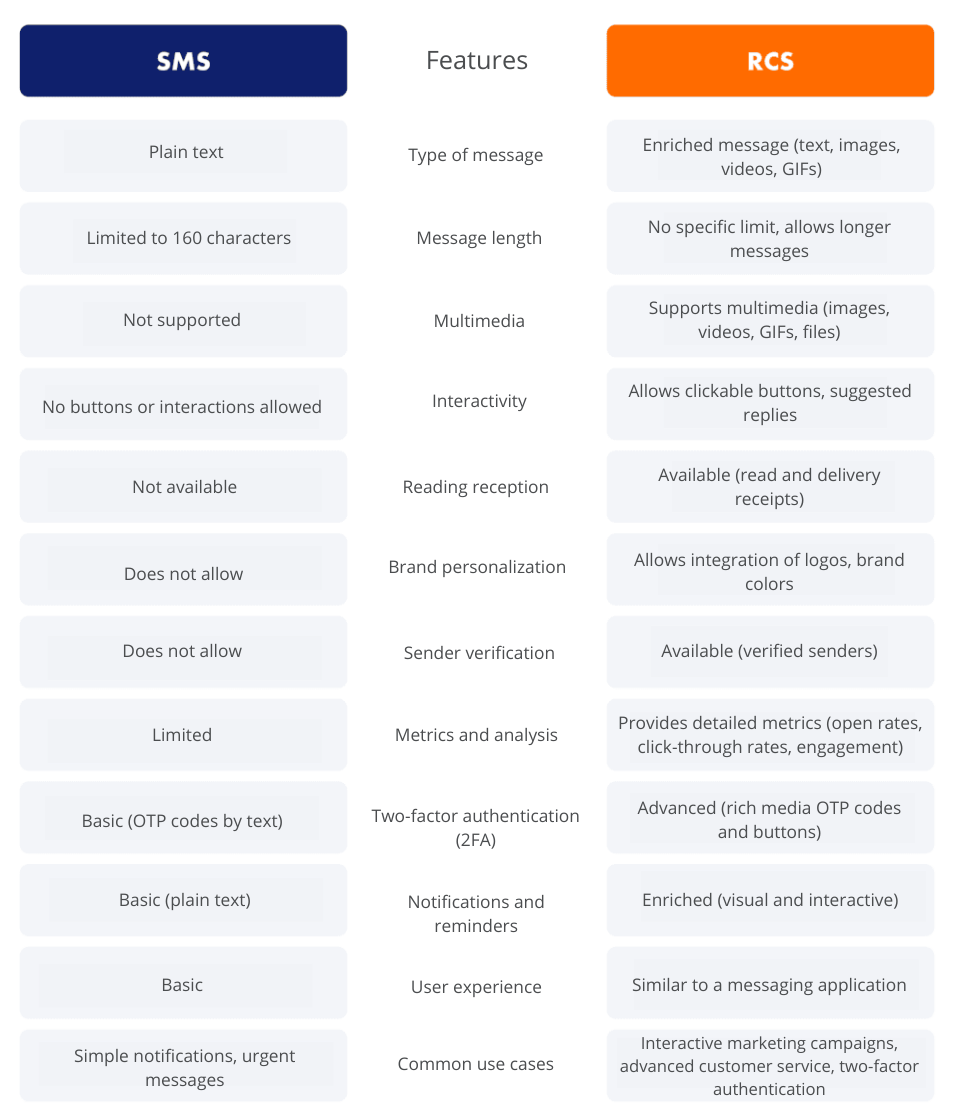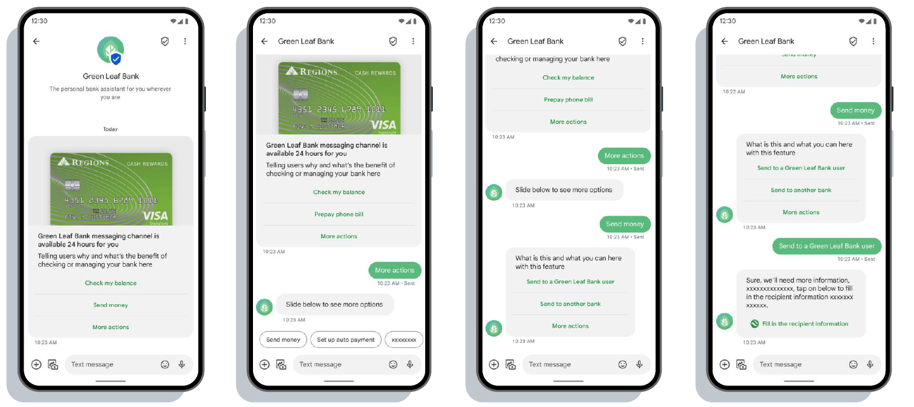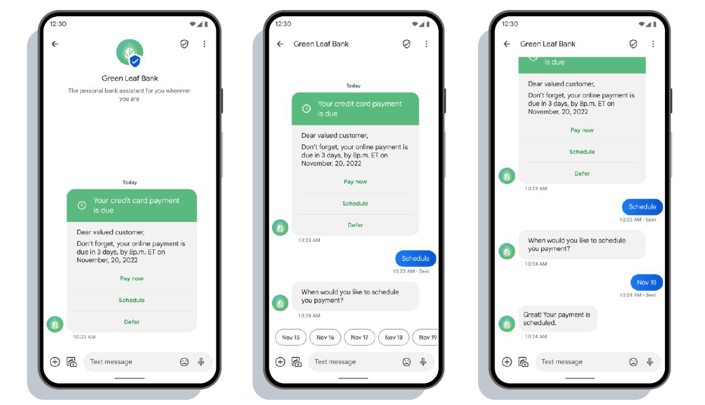
I’m Mireia Ferrer, Partners Program Manager at Latinia, and I’d like to share the findings from my research on how Rich Communication Services (RCS) are being integrated into the banking world and how this technology is poised to transform communication in the financial sector.
1. What is RCS?
RCS is an upgrade to the traditional SMS service that offers enhanced messaging capabilities. It allows users to send multimedia messages, share files, and create group chats, all within the phone’s default messaging app. RCS is integrated directly into the device’s messaging app, providing a seamless and richer user experience.
Key Differences Between SMS and RCS
Unlike SMS, which is limited to simple 160-character text messages, RCS enables users to send longer messages packed with multimedia content. It also offers features like read receipts, delivery notifications, and suggested replies, creating a more interactive and transparent communication experience. These capabilities make RCS a powerful tool for modern messaging.
RCS adoption has surged, with support from mobile carriers and device manufacturers around the globe. Google has been a key player in driving RCS forward, integrating it into the Android Messages app and working with carriers to expand its availability. Recently, Apple announced that iOS 18 will support RCS as well, further increasing its reach. These developments have led to broader adoption, establishing RCS as an essential tool for modern mobile communication.

RCS and SMS are messaging platforms with different features. While SMS is limited to 160-character text messages and does not support multimedia, RCS allows rich messages that include images, videos and files. Additionally, RCS supports advanced features such as read receipts, suggested replies and brand personalization, far exceeding the capabilities of SMS.

Advantages of RCS over SMS
- Enhanced Interactivity: RCS allows messages with clickable buttons and suggested responses.
- Multimedia Content: Messages can include images, videos, GIFs and more.
- Customized Branding: Ability to integrate logos and brand colors into messages.
- Sender Verification: Guarantees the authenticity and security of messages.
- Detailed Metrics: Provides data on open, click and engagement rates.
When to Use RCS vs. SMS
- RCS: Perfect for interactive marketing campaigns, advanced customer service, enriched notifications, and two-factor authentication.
- SMS: Best for simple, urgent messages, particularly in areas with limited internet connectivity or on devices that don’t support RCS.
2. RCS Business Messaging (RBM)
What is RBM?
RCS Business Messaging (RBM) is an advanced evolution of business messaging that combines the rich features of RCS with tailored functionalities for businesses. It enables organizations to send interactive and multimedia messages directly to customers’ default messaging apps, eliminating the need for additional app installations. This creates a more engaging and effective user experience.
Key Features of RBM
- Multimedia Messaging: Send images, videos, GIFs, and audio files.
- Interactivity: Include clickable buttons, suggested replies, and content carousels.
- Custom Branding: Add logos, brand names, and corporate colors.
- Sender Verification: Ensure security and authenticity with verified senders.
- Metrics and Analytics: Track details like open rates, clicks, and engagement.
Comparing RBM to Other Business Messaging Channels
RBM stands out from other business messaging channels like SMS, mobile apps, and email by offering unique advantages:
- SMS: Limited to text with a 160-character cap. No multimedia capabilities or branding options.
- Mobile Apps: Require installation and frequent updates. Notifications can be less effective.
- Email: High spam rates and slower response times compared to instant messaging.
3. Benefits of RCS and RBM for Businesses
Enhanced Customer Experience
RBM allows for richer, more personalized interactions, delivering an app-like experience directly within the messaging inbox. This helps capture customer attention and boosts satisfaction.
Increased Conversion and Sales Rates
With its interactive and multimedia features, RBM significantly enhances conversion rates. Action buttons and visually engaging content make it easier for customers to respond and take action, driving sales.
Companies using RBM report improved metrics, such as open rates over 80%, click rates up to 40%, and significant increases in conversions and sales. These results highlight the positive impact of RBM on communication and marketing strategies.

Personalization and Branding in Messages
RBM allows businesses to integrate branding elements directly into messages, such as logos and corporate colors. This enhances brand recognition and trust, making messages more effective and less likely to be marked as spam.

Source: Infobip
4. Use Cases and Practical Applications
Interactive Marketing
RBM takes interactive marketing to the next level by allowing businesses to create more engaging and dynamic campaigns. With features like images, videos, and clickable buttons, brands can grab consumer attention and encourage direct interaction. This boosts engagement and enhances brand perception by delivering more personalized and relevant experiences.
Customer Service
RBM transforms customer service by enabling quick, automated responses through chatbots and offering richer, more contextual communication. Businesses can send important notifications, address common issues, and provide real-time status updates, all of which improve efficiency and customer satisfaction.
Two-Factor Authentication (2FA)
Using RBM for two-factor authentication adds an extra layer of security while enhancing the user experience. Messages can include OTPs (one-time passwords) with clear instructions and interactive buttons to streamline the authentication process. This reduces the risk of fraud and increases user trust in the security of the system.
Notifications and Reminders
RBM enables sending enriched and personalized notifications and reminders, such as order updates, appointment reminders, and event alerts. These messages, being more visual and interactive, are more effective at grabbing user attention and ensuring that critical information doesn’t get overlooked.

Source: Infobip
Lessons Learned and Best Practices
Successful RBM implementations have highlighted several key lessons, including the importance of personalization, the need for a rich content strategy, and the value of integrating with other communication channels. Adopting a customer-centric approach and leveraging RBM’s interactive features are crucial for maximizing its effectiveness.
5. Challenges and Considerations
Adopting RCS and RBM comes with several challenges, including fragmentation in implementation by carriers, variability in device support, and the need to educate both consumers and businesses about their benefits.
Security and privacy are crucial in implementing RCS and RBM. While RCS offers sender verification and encryption, businesses must ensure their practices comply with data protection regulations and that users trust the platform’s security.
Technological barriers include interoperability between carriers and devices, as well as inconsistencies in service quality. Market barriers involve the need for carrier and manufacturer support, as well as consumer acceptance.
6. Integrating RCS at Latinia
At Latinia, we are dedicated to innovation and continuously enhancing our communication channels. We will soon integrate RCS (Rich Communication Services) alongside Push, SMS, email, and WhatsApp. This integration will enable businesses to leverage the benefits of RCS within a unified messaging ecosystem, improving customer interactions in a more effective and secure manner.
Benefits of RCS in Latinia’s Ecosystem
- Enhanced Interaction: RCS provides a richer and more immersive user experience compared to traditional SMS, allowing for multimedia messages, interactive buttons, and chatbots. This significantly boosts customer engagement.
- Increased Security: Like our other channels, RCS will benefit from Latinia’s robust security measures, ensuring the integrity and confidentiality of communications.
- Unified Ecosystem: RCS will be integrated into our base architecture, LIMSP©, enabling centralized and efficient management of all communication channels. Businesses will have a single access point to manage their multichannel communications, gain detailed analytics, and handle all communication strategies from the Latinia platform.
Technical Features of RCS Integration at Latinia
- Microservices Architecture: The RCS implementation will leverage our microservices architecture, ensuring scalability, high availability, and easy maintenance of the deployed services.
- Real-Time Processing: Our platform will enable RCS to process and analyze events in real time, ensuring timely and relevant delivery of notifications.
- Traceability and Auditing: Every RCS message will include complete traceability and detailed auditing, allowing businesses to monitor and evaluate the effectiveness of their communications.
7. The Future of RCS and RBM
Business messaging is continually evolving with the growing adoption of RCS and RBM. Emerging trends include integrating artificial intelligence to enhance personalization and automation, as well as using advanced analytics to optimize messaging campaigns. Additionally, we can expect increased use of interactive chatbots for customer service and marketing.

Innovations in RCS and RBM include advancements in security with enhanced encryption and sender verification, as well as the ability to integrate mobile payments directly into messages. Additionally, greater interoperability between carriers and devices is anticipated to ensure a consistent and reliable user experience.
In 2023, the global RCS Business Messaging market was valued at approximately $10 billion. This reflects the technology’s adoption and support from carriers and manufacturers worldwide. By 2028, the market is projected to reach $22 billion, indicating a significant increase in the adoption and use of RCS and RBM across various industries, driven by the growing demand for more interactive and personalized communications with consumers.

Conclusion
RCS and RBM provide a richer, more interactive, and personalized communication experience compared to traditional SMS. Key benefits include higher open and conversion rates, enhanced branding capabilities, and detailed metrics that help businesses refine their communication strategies.
In the banking industry, adopting RCS and RBM can significantly transform customer interactions by offering secure notifications, two-factor authentication, and personalized services. This enhances customer satisfaction and builds greater trust in financial institutions.
For businesses, adopting RCS and RBM is crucial to staying competitive and improving customer experience. Implementing these technologies presents unique opportunities to personalize communication, boost efficiency, and gain a market edge.
With RCS integrated into our ecosystem, banks will be able to manage all their communications through a single access point, streamlining their communication strategies for better efficiency and effectiveness. Our robust architecture ensures scalability, availability, and easy maintenance of services, while our decision engine handles real-time processing and analysis, delivering timely and relevant notifications.
I’m confident that incorporating RCS at Latinia will enhance both the quality and security of communications, providing our clients with a richer and more interactive experience. This advancement positions Latinia at the forefront of innovation in the financial sector, offering cutting-edge tools that improve customer interaction and satisfaction, and setting a new benchmark for mobile communications in banking.
Mireia Ferrer
Partner Program Manager at Latinia


